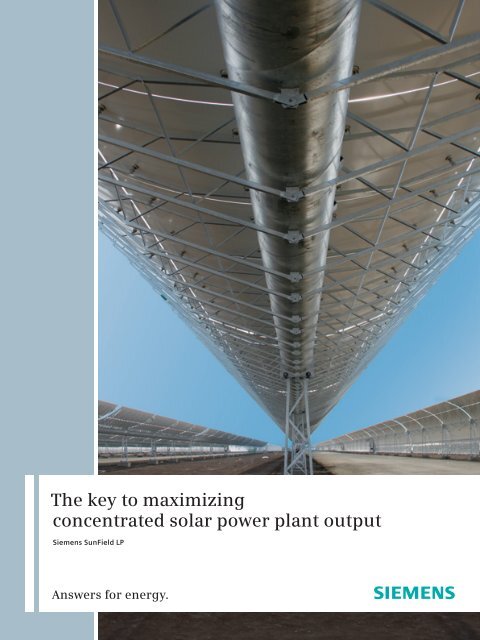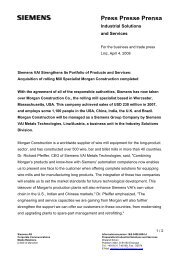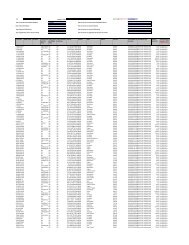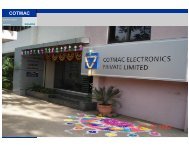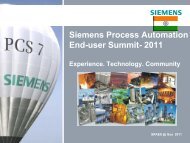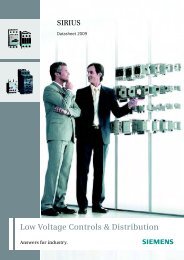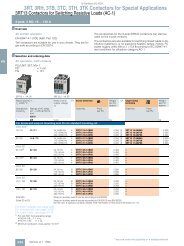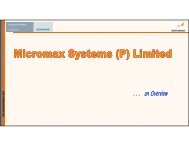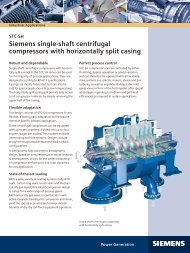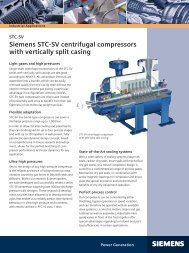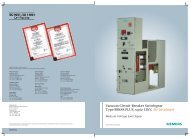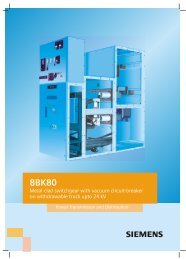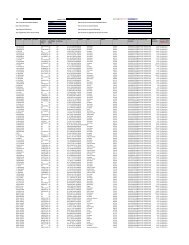The key to maximizing concentrated solar power plant ... - Siemens
The key to maximizing concentrated solar power plant ... - Siemens
The key to maximizing concentrated solar power plant ... - Siemens
Create successful ePaper yourself
Turn your PDF publications into a flip-book with our unique Google optimized e-Paper software.
<strong>The</strong> <strong>key</strong> <strong>to</strong> <strong>maximizing</strong><br />
<strong>concentrated</strong> <strong>solar</strong> <strong>power</strong> <strong>plant</strong> output<br />
<strong>Siemens</strong> SunField LP<br />
Answers for energy.
Making <strong>solar</strong> energy<br />
precise and efficient<br />
<strong>Siemens</strong> designs reliable, efficient, and optimized<br />
<strong>solar</strong> field solutions<br />
Solar fields generate clean, carbon-free, renewable energy from<br />
an endless resource. <strong>The</strong>y contribute <strong>to</strong> a more sustainable and<br />
ecologically sound <strong>power</strong> generation landscape. However, like<br />
any other <strong>power</strong> generation project, <strong>solar</strong> fields are, first and<br />
foremost, expected <strong>to</strong> perform at maximum levels and generate<br />
revenue. That is why they must prove their inherent financial<br />
feasibility before implementation.<br />
However, sound project planning can easily become problematic<br />
due <strong>to</strong> the technical complexity of a <strong>solar</strong> field. If all<br />
of the critical <strong>solar</strong> components are delivered from multiple<br />
sources and providers, both delivery and performance risk<br />
can increase.<br />
<strong>The</strong> SunField LP from <strong>Siemens</strong> is a groundbreaking <strong>solar</strong><br />
field concept designed <strong>to</strong> address these issues. Its vertically<br />
integrated concept can help reduce project risks and reduce<br />
costs considerably for both inves<strong>to</strong>rs and EPCs. It can enable<br />
more precise cost control, performance optimization of the<br />
entire trough, streamlined construction and an outstanding<br />
degree of electrical production at an excellent price/<br />
performance ratio.<br />
2<br />
<strong>Siemens</strong> manufactures and supplies all of the relevant <strong>solar</strong><br />
field components, from <strong>solar</strong> receivers <strong>to</strong> parabolic reflec<strong>to</strong>rs<br />
and <strong>solar</strong> collec<strong>to</strong>r assemblies (SCA). As a single source supplier<br />
for an entire <strong>solar</strong> field, <strong>Siemens</strong> takes advantage of its decades<br />
of research and development in <strong>solar</strong> <strong>power</strong>, as well as its<br />
significant experience in testing, calibrating and optimizing<br />
parabolic trough performance.<br />
<strong>The</strong> result is a reliable, highly efficient <strong>solar</strong> field solution based<br />
on commercially proven tech nology. As such, the SunField LP<br />
can suit inves<strong>to</strong>rs’ and EPCs’ operational and financial models<br />
and promote bankability.<br />
Solar <strong>power</strong> expertise and technology at your fingertips<br />
<strong>The</strong> SunField LP is a vertically integrated concept in which<br />
all critical heat-generating components are designed and<br />
manufactured <strong>to</strong> work harmoniously and are delivered as a<br />
package. This can facilitate the development of <strong>solar</strong> thermal<br />
<strong>power</strong> <strong>plant</strong>s by providing developers with a single-source<br />
solution for all critical components of the entire <strong>solar</strong> field. It<br />
opens the highly promising <strong>solar</strong> thermal market for interested<br />
parties possessing initiative and financing, but lacking the<br />
essential technical expertise.
8<br />
1. Solar energy is <strong>concentrated</strong> by the mirrors on<strong>to</strong> the<br />
receivers. Solar collec<strong>to</strong>rs rotate <strong>to</strong> maximize the<br />
capture of <strong>solar</strong> energy.<br />
2. Heat transfer fluid (HTF) is circulated and heated<br />
through the <strong>solar</strong> field loops. Cooled HTF returns<br />
for reuse.<br />
3. Oil pumps circulate the oil through the <strong>solar</strong> field.<br />
4. Heat exchangers forward the thermal energy from<br />
the HTF system <strong>to</strong> the water/steam (W/S) system.<br />
7<br />
6<br />
5<br />
1<br />
4<br />
5. <strong>The</strong> W/S cycle transfers the thermal energy from the<br />
heat exchangers <strong>to</strong> the steam turbine.<br />
6. <strong>The</strong> steam turbine converts thermal energy <strong>to</strong> electric<br />
<strong>power</strong>.<br />
7. <strong>The</strong> cooling <strong>to</strong>wer cools the water cycle.<br />
8. Clean <strong>power</strong> is delivered <strong>to</strong> the end users via the<br />
<strong>power</strong> grid.<br />
9. Central control optimizes <strong>solar</strong> <strong>power</strong> <strong>plant</strong> operations.<br />
3<br />
2<br />
9<br />
5
All critical components in one system<br />
<strong>Siemens</strong> SunField LP<br />
A high degree of integration and harmonization<br />
helps provide high efficiency<br />
A <strong>solar</strong> field collects sunshine, concentrates it, converts it<br />
in<strong>to</strong> thermal heat, and, finally, in<strong>to</strong> electrical <strong>power</strong>. While<br />
this working principle may seem simple, it requires precise<br />
engineering and thorough research and development efforts<br />
<strong>to</strong> optimize the energy yield of the <strong>solar</strong> fields and turn <strong>solar</strong><br />
<strong>power</strong> generation in<strong>to</strong> an environmentally and economically<br />
beneficial option.<br />
<strong>The</strong> SunField LP builds upon <strong>Siemens</strong>’ long-standing<br />
engineering experience with <strong>solar</strong> fields, as well as decades<br />
of on-site testing and integration at the commercially<br />
operational <strong>solar</strong> thermal facilities in California and various<br />
test facilities. Through many years of experience and<br />
modeling, <strong>Siemens</strong> has developed optimized <strong>solar</strong> field<br />
sizes and configurations. All <strong>key</strong> components of the <strong>Siemens</strong><br />
SunField LP are precisely harmonized and coordinated<br />
with one another in order <strong>to</strong> obtain highest efficiency.<br />
Everything you need for your <strong>solar</strong> <strong>power</strong> field –<br />
from project planning <strong>to</strong> operation and maintenance<br />
<strong>The</strong> SunField LP package also includes important planning<br />
elements, including <strong>solar</strong> field design and engineering<br />
and design coordination. In addition, <strong>Siemens</strong> also offers<br />
<strong>power</strong> <strong>plant</strong> operations and maintenance services <strong>to</strong> help<br />
maximize the operational integrity of the SunField LP.<br />
Collec<strong>to</strong>r assemblies<br />
<strong>The</strong> basic component of the SunField LP <strong>solar</strong> field is the<br />
<strong>Siemens</strong> <strong>solar</strong> collec<strong>to</strong>r assemblies (SCA), a metal parabolic<br />
framework designed <strong>to</strong> hold the receiver and reflec<strong>to</strong>r panels<br />
in place and keep them perfectly aligned.<br />
Line-based production for all components and processes,<br />
rather than the project-based approach employed by other<br />
providers, helps provide the <strong>Siemens</strong> SCA with the high<br />
accuracies necessary for optimal electricity production,<br />
and can enable fast and simple assembly and installation.<br />
<strong>The</strong> SCA includes the latest advances in high <strong>to</strong>rsion stiffness,<br />
vibration damping, high stiffness against bending, and<br />
corrosion resistance. <strong>The</strong>se advances are important for<br />
consistent maximum optical efficiency. A hydraulic drive pylon<br />
and control system enable the SCA <strong>to</strong> precisely track the sun<br />
over the entire course of the day.<br />
Reflec<strong>to</strong>r panels<br />
<strong>The</strong> parabolic reflec<strong>to</strong>r panels are made up of hot-formed<br />
mirrored glass panels supported by a truss system that gives the<br />
<strong>solar</strong> collec<strong>to</strong>r assembly its structural strength. To increase the<br />
transmissivity for <strong>solar</strong> radiation, the reflecting panels with<br />
their silver-based mirror coating are made of special glass with<br />
a particularly low iron content. <strong>The</strong> reflec<strong>to</strong>r panels need <strong>to</strong> be<br />
built <strong>to</strong> the highest standards of precision and durability, as<br />
even the slightest degradation can potentially impair the overall<br />
efficiency of the <strong>power</strong> <strong>plant</strong>.<br />
3
Solar receiver<br />
<strong>The</strong> high efficiency of the UVAC 2010, which is the heart of<br />
the parabolic trough system, makes the development of<br />
relatively small, highly productive and cost-competitive <strong>solar</strong><br />
fields possible.<br />
<strong>The</strong> UVAC 2010 is designed for extremely low heat loss and<br />
high transmissivity. It is characterized by its superior thermal<br />
efficiency, which helps significantly increase the electrical<br />
output of a <strong>solar</strong> <strong>power</strong> <strong>plant</strong>. Its optical and thermal properties<br />
provide for outstanding heat creation compared <strong>to</strong> other<br />
available receivers.<br />
<strong>The</strong> UVAC 2010 is composed of a selectively coated stainless<br />
steel tube within an anti-reflective evacuated glass tube. <strong>The</strong><br />
UVAC 2010 includes <strong>Siemens</strong>’ patented vacuum maintenance<br />
unit and the anti-”fluorescent phenomenon” coating, designed<br />
<strong>to</strong> provide stable performance over time, even under extreme<br />
conditions.<br />
Components of the <strong>Siemens</strong> UVAC 2010<br />
1. Coated stainless steel absorber tube<br />
2. Coated glass sleeve enclosure<br />
3. Glass-<strong>to</strong>-metal joint<br />
4. Bellows<br />
5. Hydrogen and barium getters<br />
6. External shields<br />
7. Internal shield<br />
6<br />
1<br />
2<br />
5<br />
Field supervisory control<br />
A specially designed, advanced field control system assures the<br />
efficient collection of <strong>solar</strong> radiation. At the core of this system<br />
is a specialized sun position sensor. It enables precise tracking<br />
and focus of the sun’s rays on<strong>to</strong> the UVAC, and periodically<br />
sends commands <strong>to</strong> a drive system designed <strong>to</strong> position the<br />
SCA for optimal effect. <strong>The</strong> control system consists of local<br />
microprocessor controllers on each SCA and a field supervisory<br />
controller in the central control building, where the opera<strong>to</strong>rs<br />
moni<strong>to</strong>r the status of each SCA and all operational values,<br />
including <strong>solar</strong> insolation, wind velocity and HTF temperature.<br />
An interactive user interface contributes <strong>to</strong> the system for userfriendliness<br />
and responsiveness.<br />
Solar field modeling<br />
<strong>Siemens</strong> has designed a complex <strong>solar</strong> field operational model<br />
<strong>to</strong> complement the SunField LP. <strong>The</strong> model simulates the<br />
operating modes of the <strong>solar</strong> field, uses meteorological data <strong>to</strong><br />
perform a heat balance calculation at certain time intervals<br />
throughout the year, and provides a calculated estimate of<br />
potential output over the lifetime of the <strong>power</strong> <strong>plant</strong>. Optical<br />
interaction fac<strong>to</strong>rs, transient conditions, start-ups and changing<br />
weather conditions are all taken in<strong>to</strong> consideration. <strong>The</strong> results<br />
are provided in terms of yearly and hourly values, and are<br />
verified and calibrated on the basis of results from various<br />
<strong>plant</strong>s in operation.<br />
7 3<br />
4<br />
Schematic of a <strong>solar</strong> trough<br />
3.23 m<br />
1.53 m<br />
5.77 m<br />
4
Published by and copyright © 2010:<br />
<strong>Siemens</strong> AG<br />
Energy Sec<strong>to</strong>r<br />
Freyeslebenstrasse 1<br />
91058 Erlangen, Germany<br />
<strong>Siemens</strong> AG<br />
Energy Sec<strong>to</strong>r<br />
Renewable Energy Division<br />
Solar Power<br />
Hugo-Junker-Strasse 15<br />
90411 Nürnberg, Germany<br />
<strong>Siemens</strong> Concentrated Solar Power Ltd.<br />
3 Hac’shara Street<br />
99107 Beit Schemesh, Israel<br />
For more information, please contact<br />
our Cus<strong>to</strong>mer Support Center.<br />
Phone: +49 180 524 70 00<br />
Fax: +49 180 524 24 71<br />
(Charges depending on provider)<br />
E-mail: support.energy@siemens.com<br />
Renewable Energy Division<br />
Order No. E50001-W320-A112-X-4A00<br />
Printed in Germany<br />
Dispo 34807, c4bs No. 7827<br />
fb 2839 440321 WS 06102.0<br />
Printed on elementary chlorine-free<br />
bleached paper.<br />
All rights reserved.<br />
Trademarks mentioned in this document<br />
are the property of <strong>Siemens</strong> AG, its affiliates,<br />
or their respective owners.<br />
Subject <strong>to</strong> change without prior notice.<br />
<strong>The</strong> information in this document contains<br />
general descriptions of the technical options<br />
available, which may not apply in all cases.<br />
<strong>The</strong> required technical options should therefore<br />
be specified in the contract.<br />
www.siemens.com/energy
Published by and copyright © 2010:<br />
<strong>Siemens</strong> AG<br />
Energy Sec<strong>to</strong>r<br />
Freyeslebenstrasse 1<br />
91058 Erlangen, Germany<br />
<strong>Siemens</strong> AG<br />
Energy Sec<strong>to</strong>r<br />
Renewable Energy Division<br />
Solar Power<br />
Hugo-Junker-Strasse 15<br />
90411 Nürnberg, Germany<br />
For more information, please contact<br />
our Cus<strong>to</strong>mer Support Center.<br />
Phone: +49 180 524 70 00<br />
Fax: +49 180 524 24 71<br />
(Charges depending on provider)<br />
E-mail: support.energy@siemens.com<br />
Renewable Energy Division<br />
Order No. E50001-W320-A110-X-4A00<br />
Printed in Germany<br />
Dispo 34807, c4bs No. 7827<br />
fb 2839 440321 WS 06101.0<br />
Printed on elementary chlorine-free<br />
bleached paper.<br />
All rights reserved.<br />
Trademarks mentioned in this document<br />
are the property of <strong>Siemens</strong> AG, its affiliates,<br />
or their respective owners.<br />
Subject <strong>to</strong> change without prior notice.<br />
<strong>The</strong> information in this document contains<br />
general descriptions of the technical options<br />
available, which may not apply in all cases.<br />
<strong>The</strong> required technical options should therefore<br />
be specified in the contract.<br />
www.siemens.com/energy


